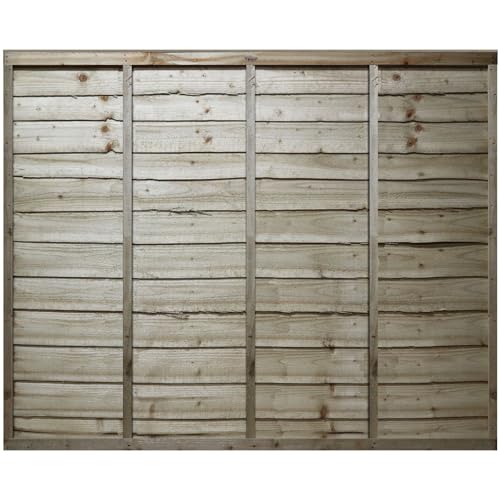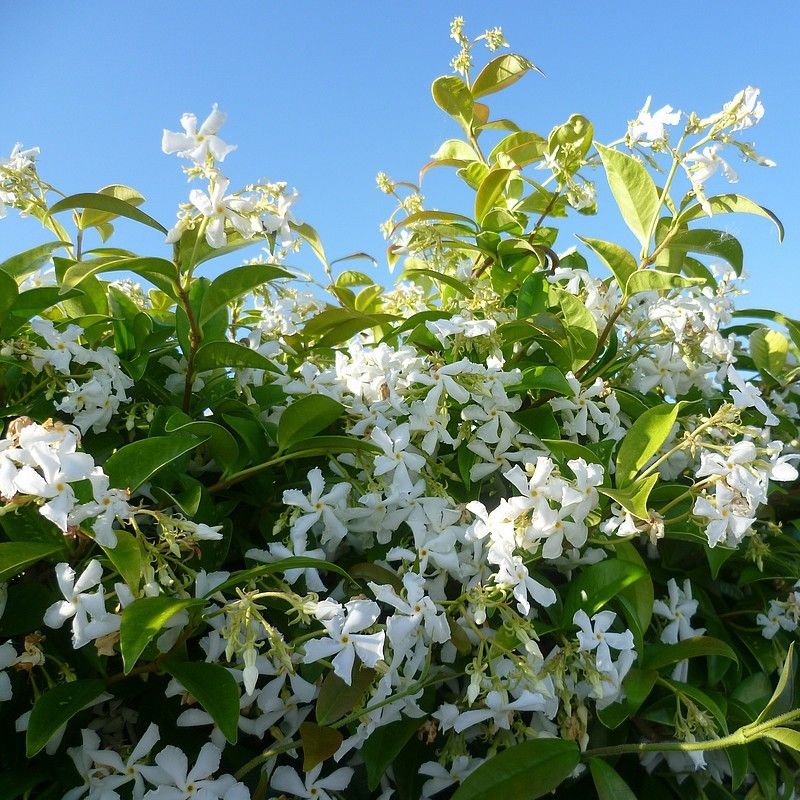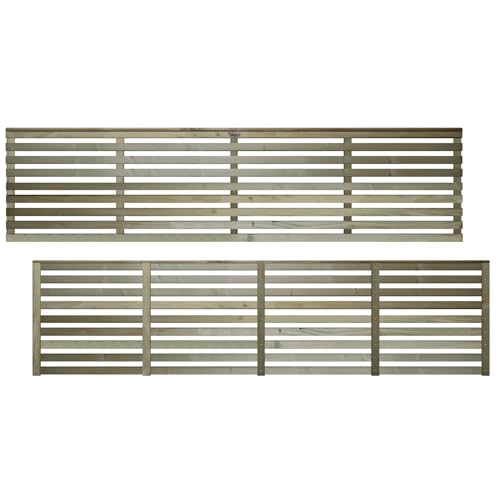Garden fence ideas – 29 ways to refresh and revamp your panels
Our favourite garden fence ideas, all in one list

EDITOR’S NOTE: An earlier version of this article included a quote from a purported expert whose credentials we have not been able to verify. The quote has been removed. We regret this lapse in our verification process and have updated our internal protocols to reduce the risk of recurrence.
Looking for garden fence ideas? With summer in full swing, we're taking the opportunity to revamp these stalwart garden features.
A huge number of garden ideas involve fences, but you don't have to stick to traditional wooden styles – there are plenty of ways to zhuzh them up, whether you're hoping to hide an ugly fence or give existing panels a freshen up.
Below, you'll find our favourite garden fence ideas right now – from quick fixes to DIY projects.
1. Apply a stain
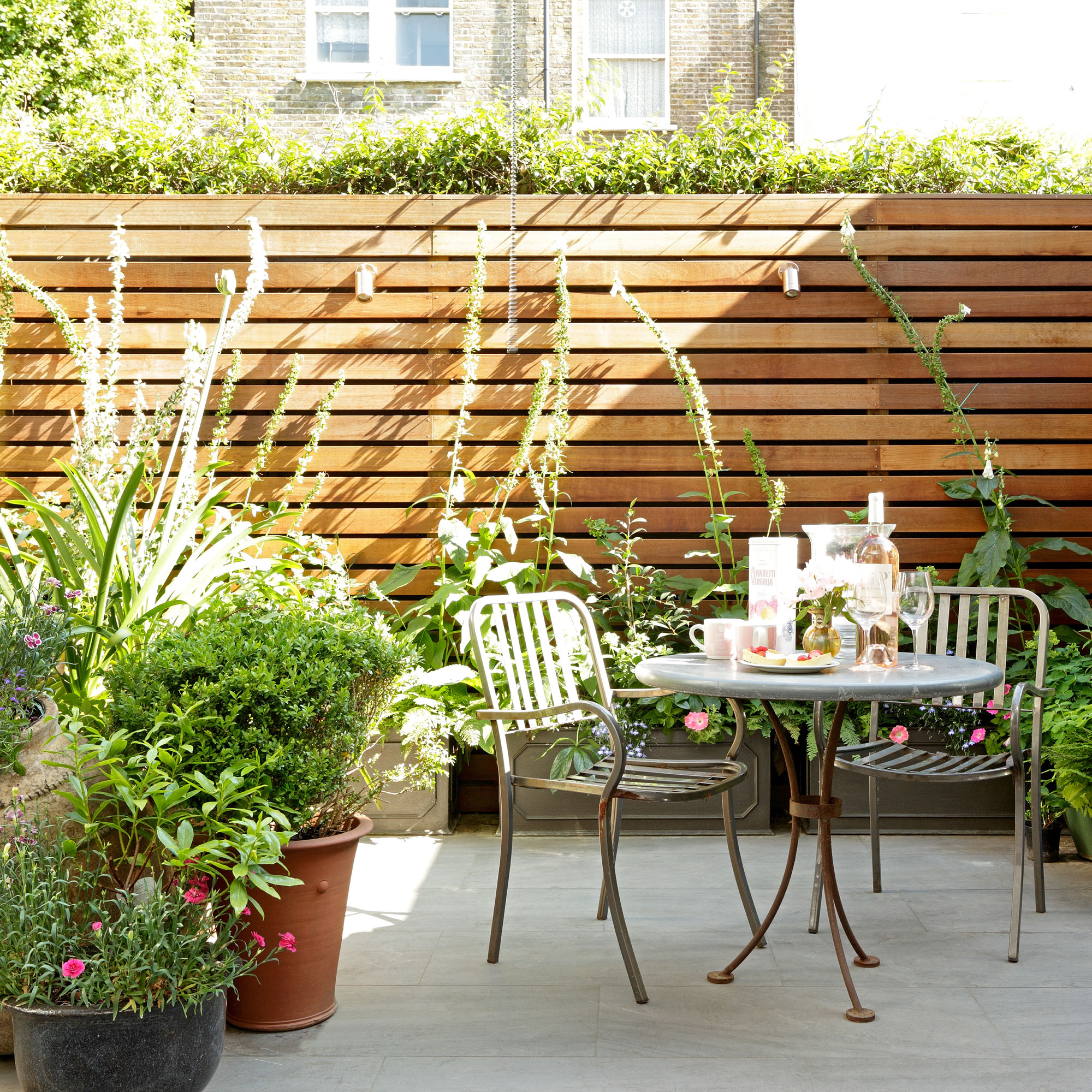
If you have wooden fence panels, one of the best ways to freshen up your garden fence ideas is by staining them.
A wood stain can enrich the look of your fence, and many products provide weatherproof protection, too, like Ronseal's One Coat Fence Life from Amazon.
'A simple coat of wood preserver like a stain can help protect the timber and give it a new lease of life,' says Michael Rolland, managing director of The Paint Shed.
2. Or, paint it black
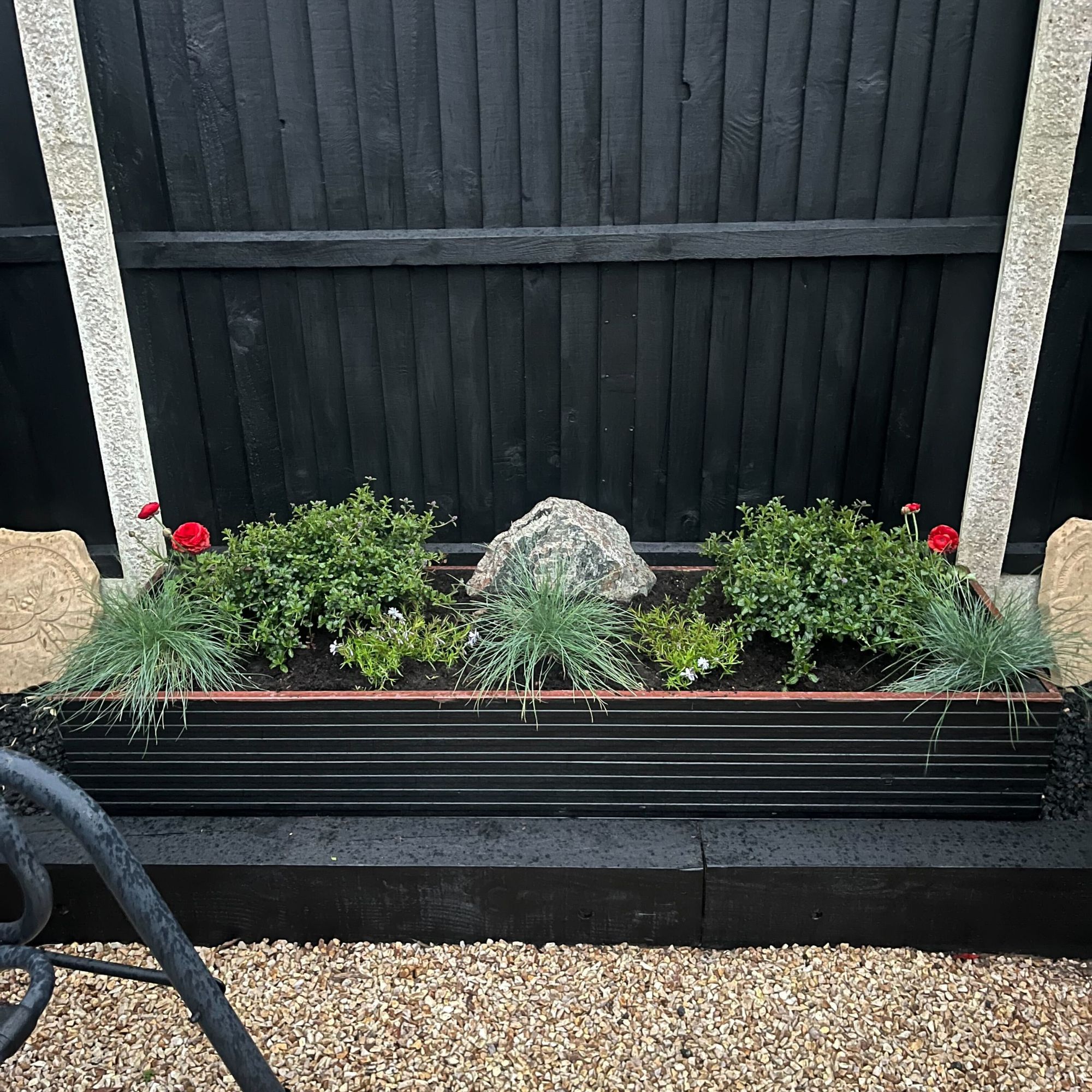
Our gardens editor Sophie’s mum recently transformed her garden fence by painting it black, and it’s created a striking contrast against the border planting.
Sign up to our newsletter for style inspiration, real homes, project and garden advice and shopping know-how
Garden paint ideas like this really make flowers and foliage pop, and it’s a brilliant way to add ambience to a garden border, especially with a few stake lights lining the way.
Sophie's mum used Protek Wood Stain & Protect in Ebony, which you can buy from Amazon.
3. Grow vertically
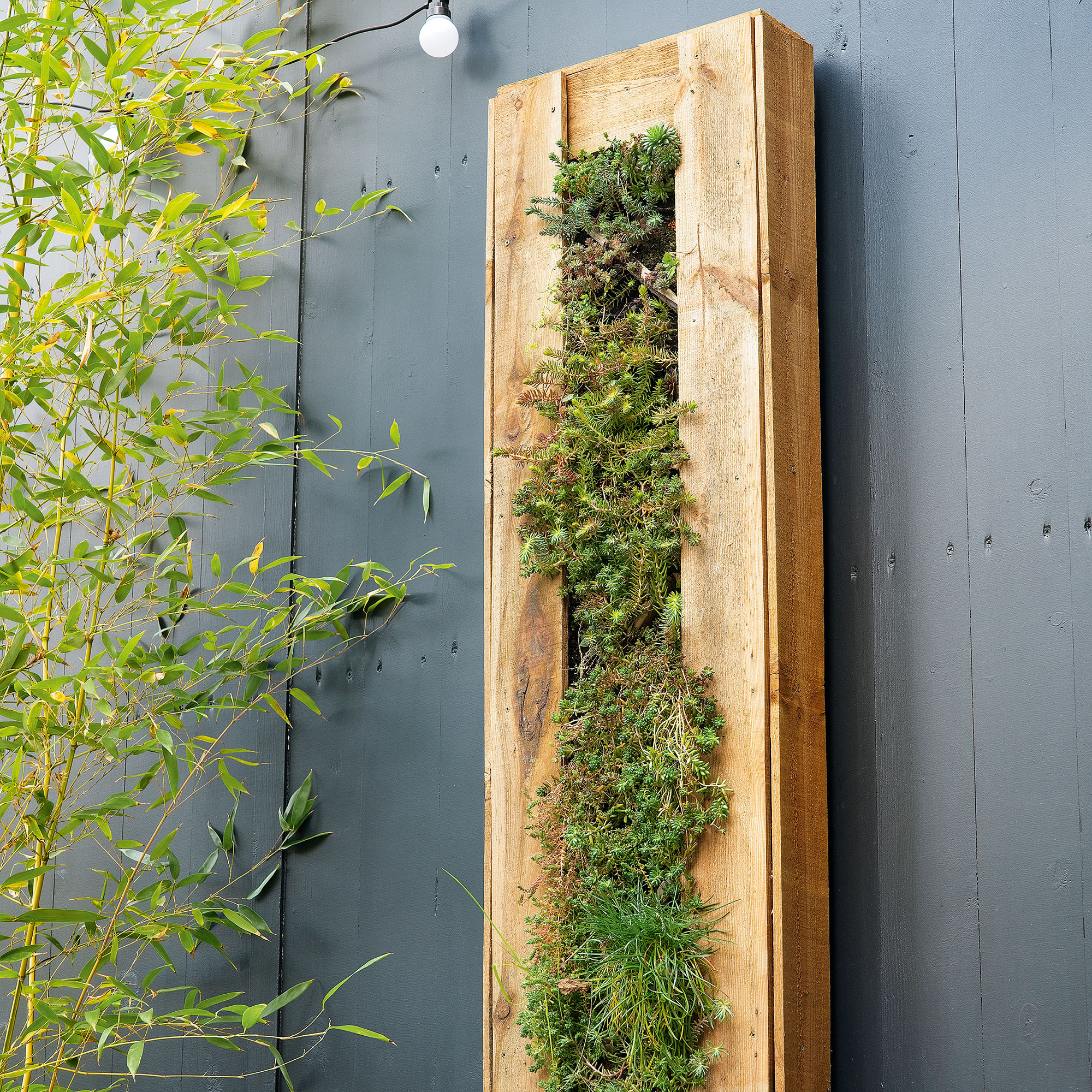
With a few vertical planting methods and living wall ideas, a fence is the ideal place to make the most of space – especially if you’re looking for small garden ideas.
‘You can attach planters, hanging pots or even a trellis to a solid panel and grow climbers like jasmine, clematis or even strawberries,’ says Henry Barker, design lead at Sona.
‘It’s a great way to soften the look of plain fencing and make your garden feel more lush, especially in urban spaces where planting space is limited. Plus, it’s easy to switch out plants seasonally.’
4. Add a fence topper
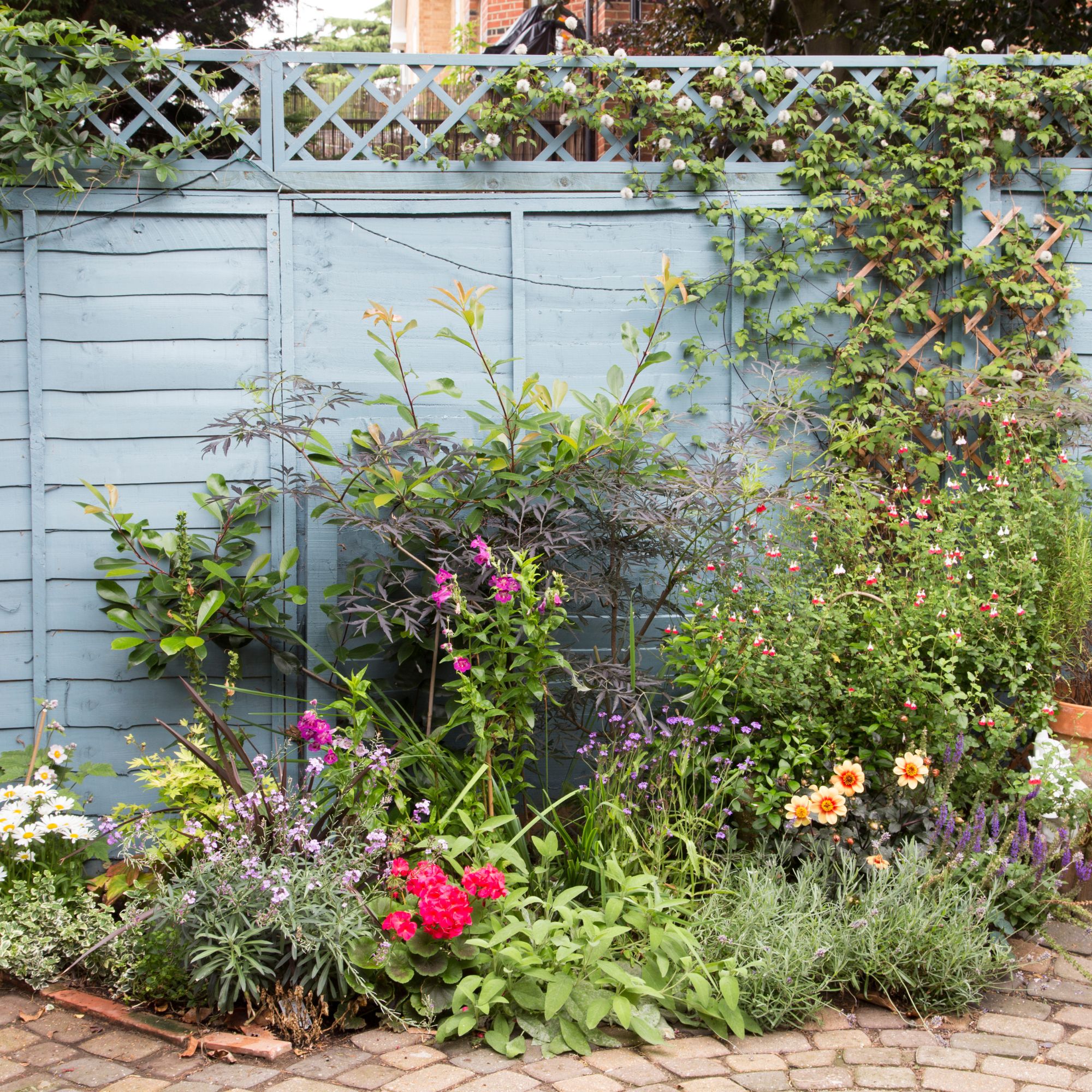
Fence toppers are available in a range of styles, from lattices to trellises. They can really boost the aesthetic appeal of regular garden fences.
'First and foremost, they can cost-effectively address a lack of privacy by adapting the fence you already have,' says Armstrong Cheshire's fence expert, Simon Wardle. 'However, the fence must remain under the 6ft legal height – unless you seek planning permission.
'Beyond privacy, they can add some cool features to the universal, uninspiring fences of the UK.'
Where to buy fence toppers:
- Robert Dyas: Go classic with the Forest Garden Diamond Lattice Fence Topper.
- Charles Bentley: Or, upgrade to this sleek composite Classic Fence Panel.
5. Adorn with climbing plants
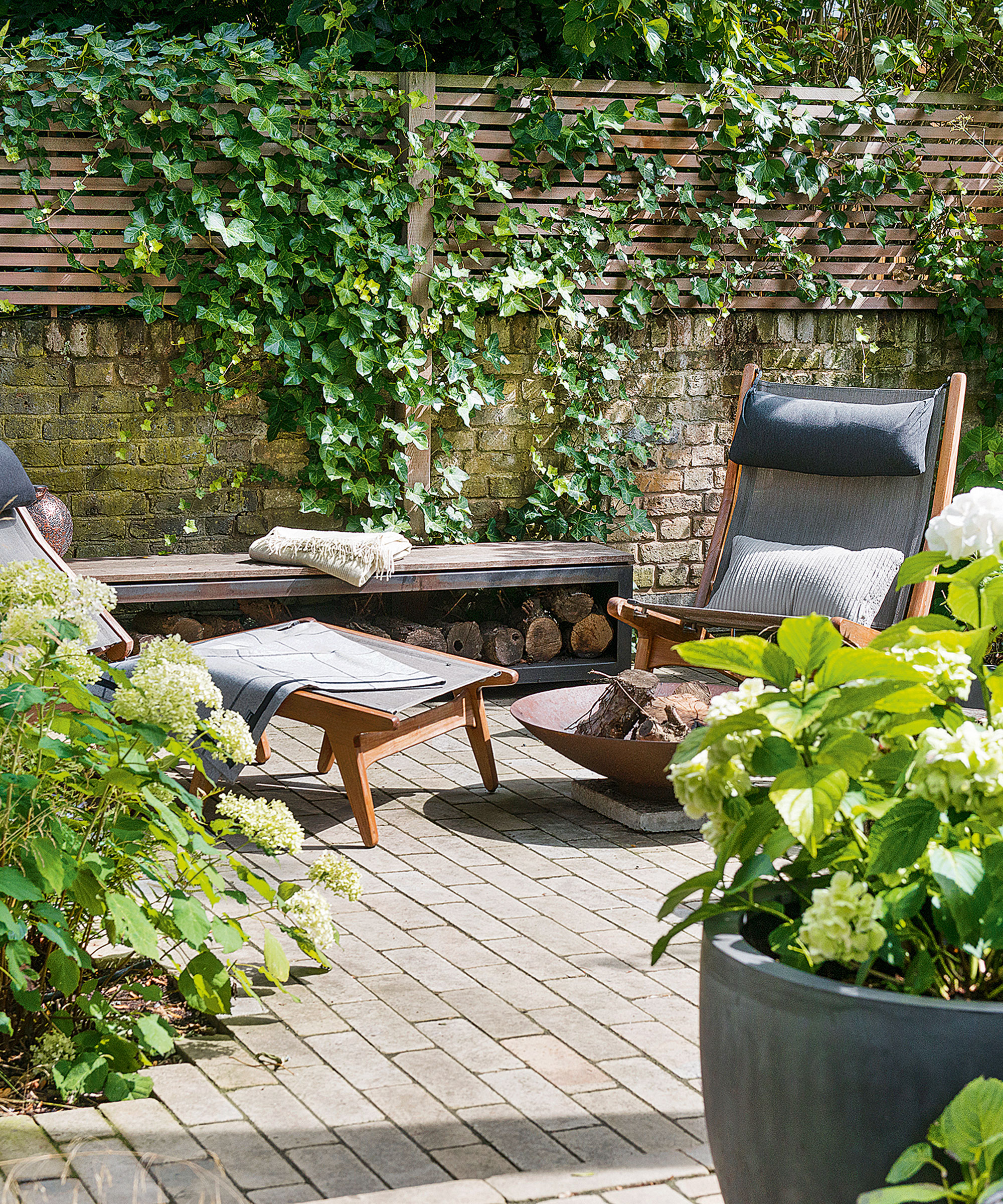
Training fast-growing climbing plants along your fence is a brilliant way to add some interest, and if you've got an openwork fence topper, the plants can fill in the gaps for added privacy.
The options are endless when choosing which climbing plants to grow along your fence, whether you learn how to grow jasmine (and you can buy a star jasmine plant from Gardening Express) or clematis.
‘Don't forget about morning glory (Ipomoea purpurea),’ says Monique Gudgeon, garden director at Sculpture by the Lakes. 'This stunning twining plant produces great trumpet-shaped flowers of the bluest shade, which appear every morning. In the sunniest position, it will quickly cover trellises, fences or arbours.
'Seeds are easily bought from garden centres and you can treat them in much the same way as sweet peas.’
6. Consider an accent fence

An accent fence can be used to hide an ugly garden wall, or even frame different parts of the garden.
'Accent fences can be wonderful additions to your garden, adding both style and function,' says Leigh, retail sales manager at Jacksons Fencing. 'They can define spaces, create focal points, or provide a backdrop for plants.
'Consider using accent fences to highlight specific areas such as a flower bed, vegetable garden, or a seating area. Choose materials and designs that complement your overall garden aesthetic, like a decorative wooden trellis.'

Leigh has over 20 years of experience in the timber/construction industry. Since joining Jacksons Fencing in 2019, he has been instrumental in leading the retail team, focusing on driving the timber division side of the business.
7. Light up your fencing

A few garden lighting ideas will go a long way to improving the look of a fence, the ambience of your space and marking steps and paths to keep your garden safe at night.
‘Festoon garden lights can be added along any garden fence for a touch of luxury, and are perfect for illuminating your garden all year round,’ says Tom Cain, technical engineer at UltraLEDs.
If you do string LED lights along your fence all year round, they need to be suitable for all kinds of weather. Make sure they have at least an IP44 rating, like the 4lite Outdoor LED Weatherproof Festoon String Lighting from Amazon, so the lights are protected against light rainfall. If you expect heavier rainfall, choose a higher IP44 rating.
8. Use fencing as a background for seating
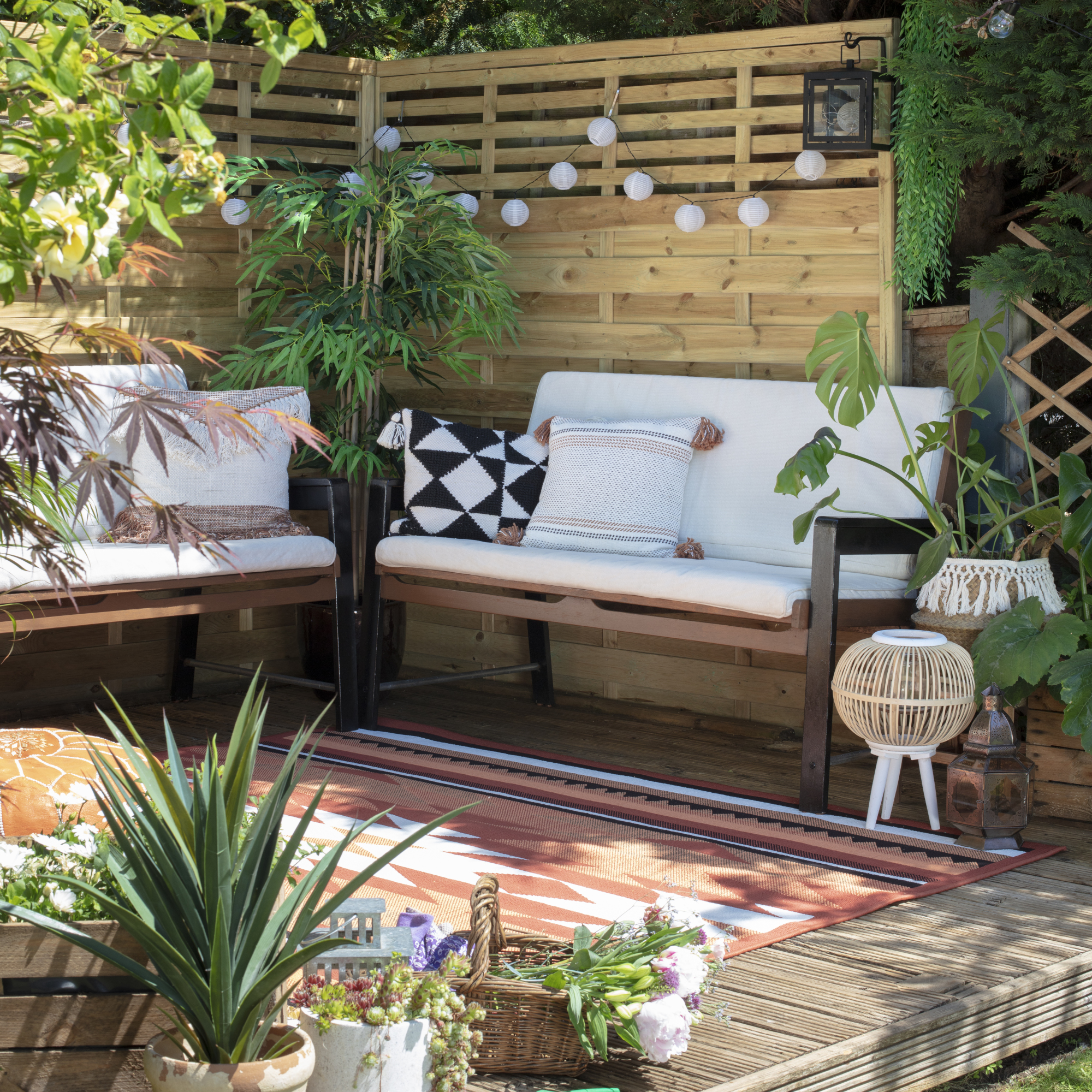
If you are lucky to have enough space for a separate garden seating area, use fences to cocoon it and create your own private seating zone.
Placing your seating in a corner with a fence on two sides creates a mini ‘room’, extending your living space out into your garden. Having the fence surround your seating area not only provides a comforting boundary but also provides added privacy from nosy neighbours.
‘Plant the fence up thickly with evergreen and herbaceous climbers which flower at different times of the year,' suggests Angela Slater, gardening expert at Hayes Garden World. 'Try and make sure there is a constant supply of colour.’
9. Use deconstructed pallets to make a fence
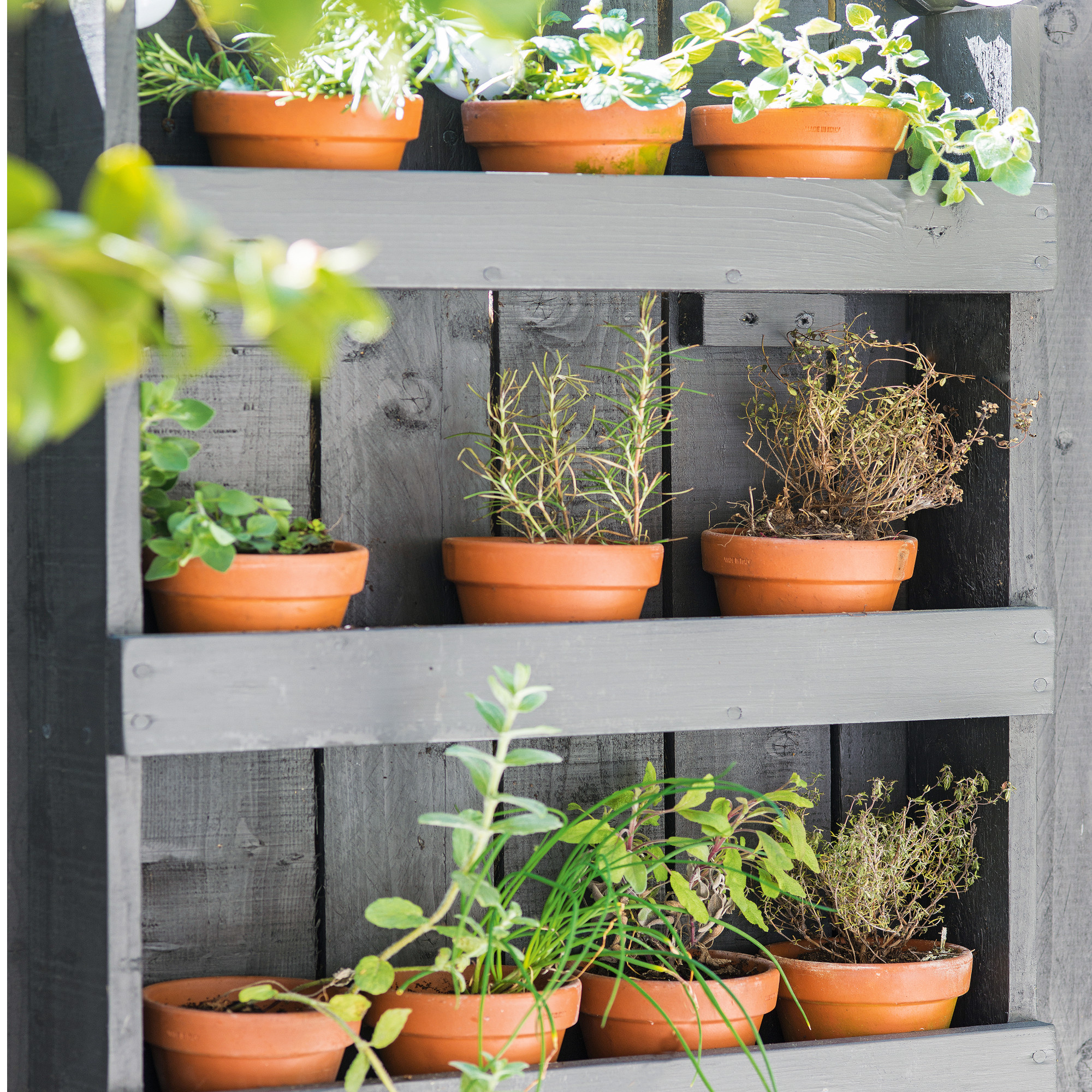
For a budget garden idea that will not only provide a solid structure but also get you hands-on with your garden fence ideas, create your fence from pallets. Pallet ideas for the garden are eco-friendly ways of giving old wood a new lease of life.
‘Deconstruct pallets and use the boards to make a fence,’ says Angela from Hayes Garden World. ‘However, they do need a post and rail frame on which to nail them. For added interest, instead of nailing on the boards in a vertical position, fasten them on at a slant or place the boards horizontally for a contemporary look.
'Deconstructed pallets do involve a little work; as they are just rough timber, they do have to be sanded down. They also need to be protected against the elements otherwise they will soon start to rot.'
Using leftover pallets for your fence prevents them from ending up on a rubbish heap and adds a rustic twist to your garden. They can be picked up very cheaply, or sometimes for free, from local businesses.
10. Place shelves on your fence
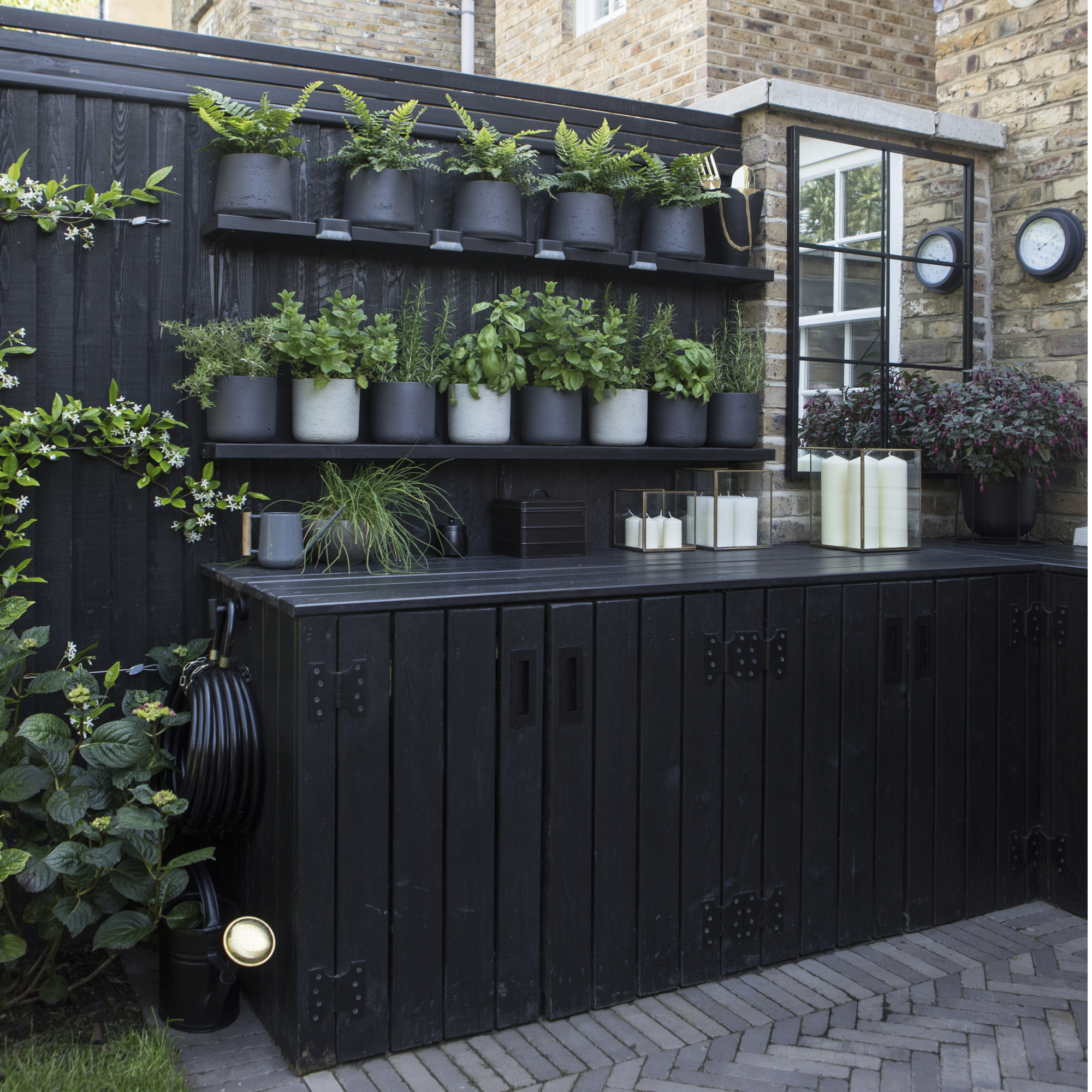
A fence with shelving provides you with not only a boundary, but also somewhere for extra storage and decoration. Shelves can maximise your garden storage ideas by holding regularly used garden tools. Or, you can place decorative potted plants on them.
If you love entertaining, use the shelves as somewhere for people to perch their drinks or plates of barbecued food.
11. Create a mixed hedge boundary
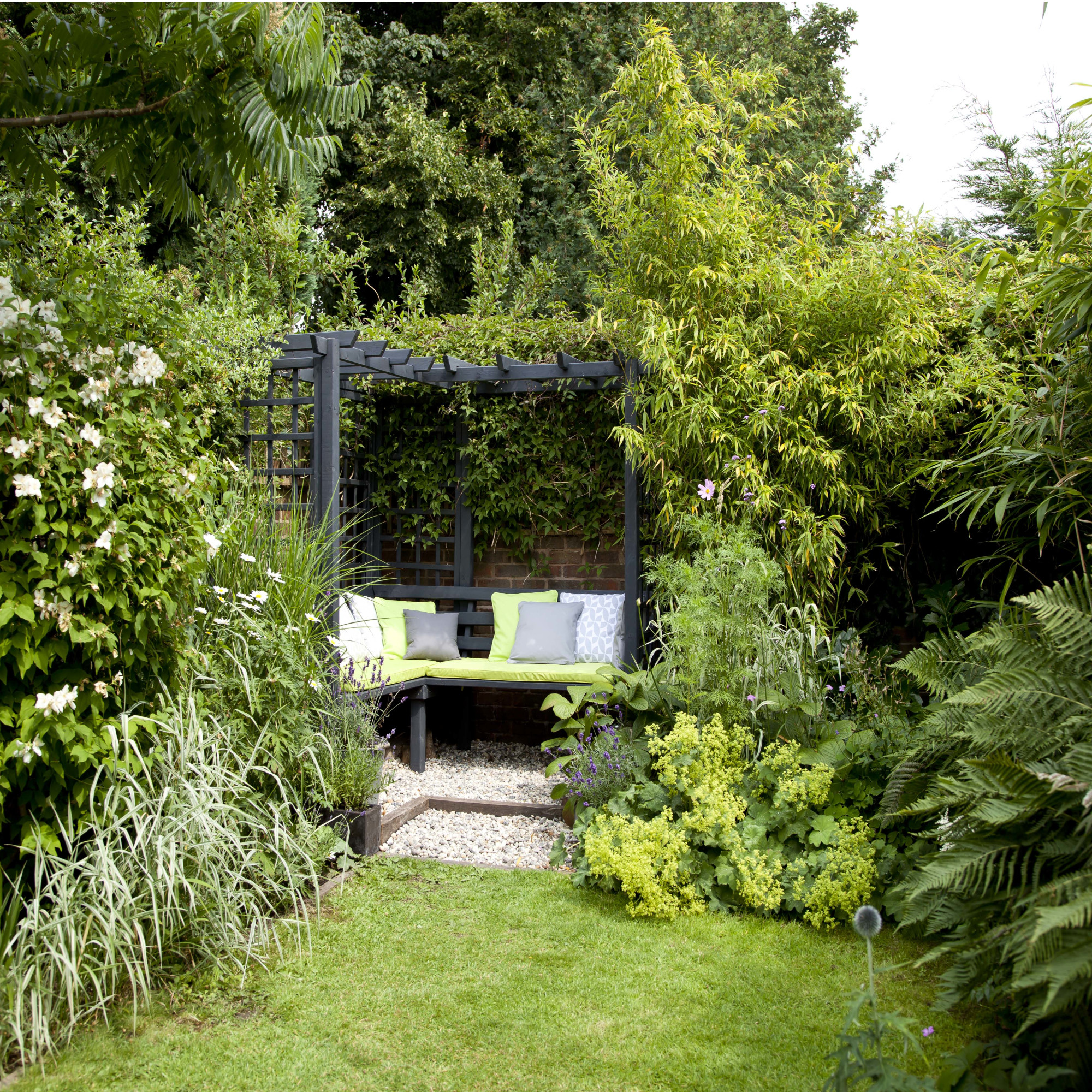
Mixed hedges provide seasonal colour to your fence all year round, and will blend in with the rest of your garden greenery. When looking at garden border ideas, hedging is a great option.
‘Growing a native mixed hedge can provide privacy, security, if you include thorny shrubs, and food and shelter for birds and small mammals,’ says Angela Slater from Hayes Garden World.
Mixed hedgerows provide both a nesting cover and a diverse source of food for animals, bringing a mix of wildlife to your garden. If you are a beginner at gardening, creating a mixed hedge fence is easy to maintain and grow because it suits a wide range of soils and climates. Unlike a single variety hedge, a mixed hedge will give you a variety of colours, shades and shapes.
When thinking about which plants to incorporate in your hedge, Photinia is an evergreen plant that has vibrant red leaves, lilacs will offer a lovely fragrance, and Sambucus has white flowers and produces black fruit.
12. Break it up with bamboo
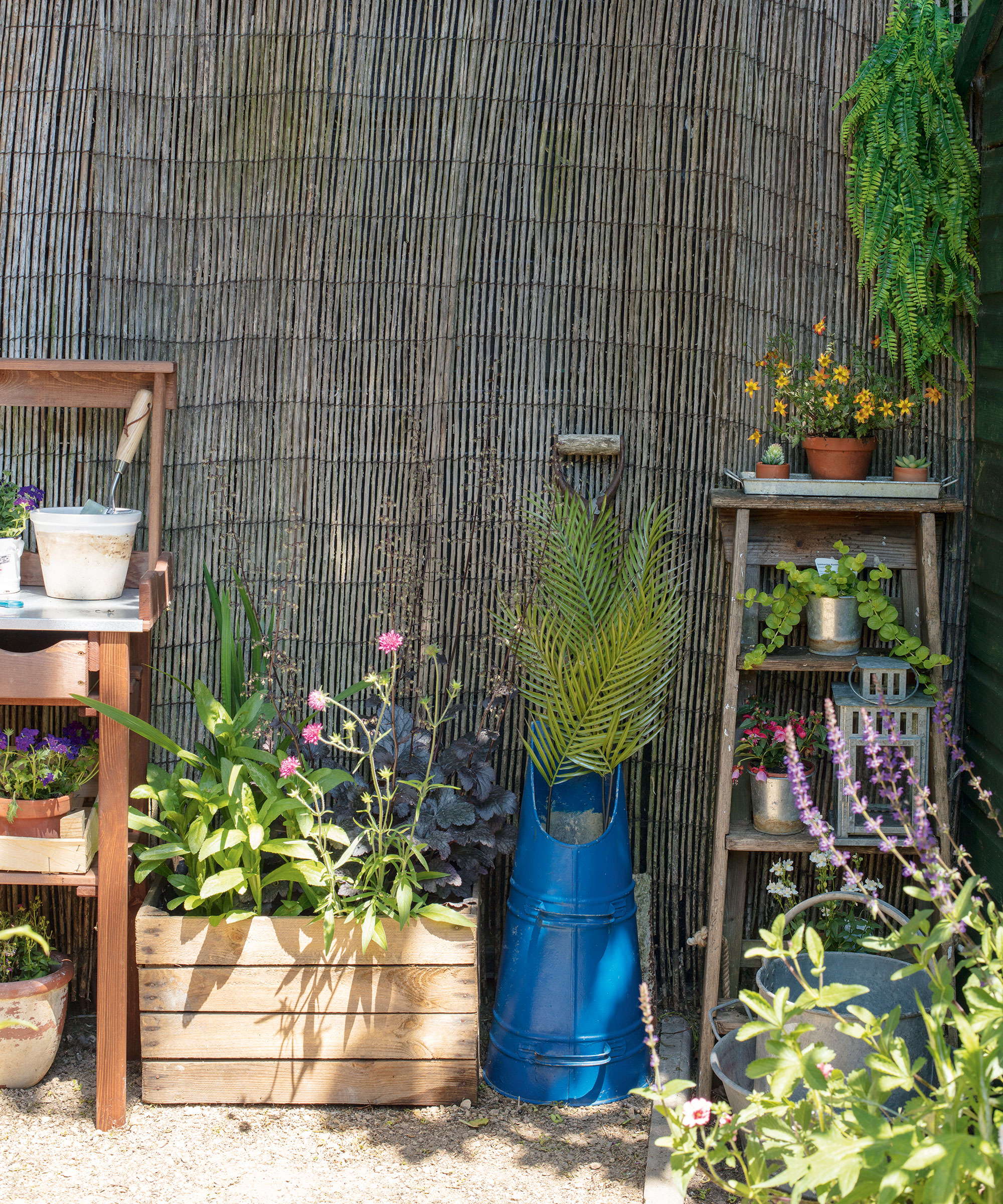
Garden fences aren't just used along the boundaries of your space – they can also be used to zone different areas within your plot.
Bamboo screens are great for this as they are lightweight, so you can install them yourself. Plus, they have a malleable quality to them, making them great for all spaces. They can be cut to the size you need, and any off-cuts make lovely flower bed borders.
Angela Slater from Hayes Garden World says, 'Woven bamboo panels are a relatively inexpensive form of fencing, but they do need a secure framework. Living bamboo plants make a quick-growing green fence – just make sure you don’t buy the invasive varieties.
'Sink slates on their edge around the space where you want the bamboo to grow – it's fairly shallow-rooted and won’t go underneath the slats, but will stay contained within their allotted area.'
13. Pop up a potting bench
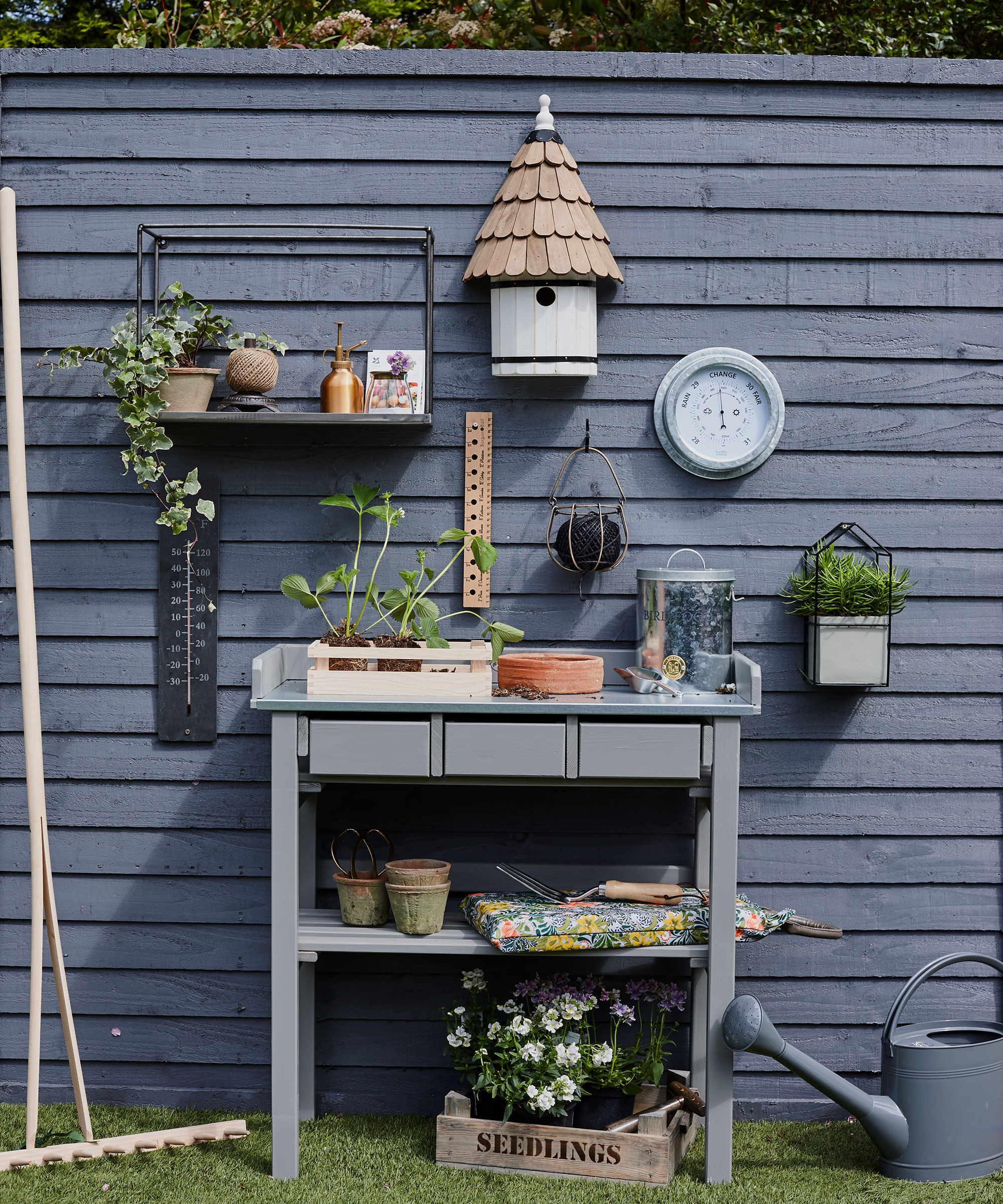
Turn your garden fence ideas into the backdrop for a potting station.
Instead of your garden ending with just a solid fence, break it a bit by setting up a potting bench and work station to enjoy all summer long. Fixing up a couple of shelves will give you space to display potted plants and garden accessories, too.
14. Echo your fencing around the garden

If you have chosen contemporary fencing that creates a feature in your garden, why not echo that feature in other areas, too? Here, the homeowner has made a bench with similar slim panels of wood to the fence behind, tying the whole space together.
Thin, horizontal slats of wood offer a modern, fresh look for fencing, and whether painted or left bare, they're perfect for courtyard gardens and turf-covered gardens alike.
15. Take it up a level

Use traditional lap fence panels to align the different levels of the perimeter of a garden. Run the design alongside an incline or stepped paving to create a continuation of the fence, rather than adding different height levels which make it feel disjointed.
Rather than staining or painting the panels, simply seal them with a coat of wood-preserving varnish for an understated finish.
16. Make a playful statement with a two-tone panel
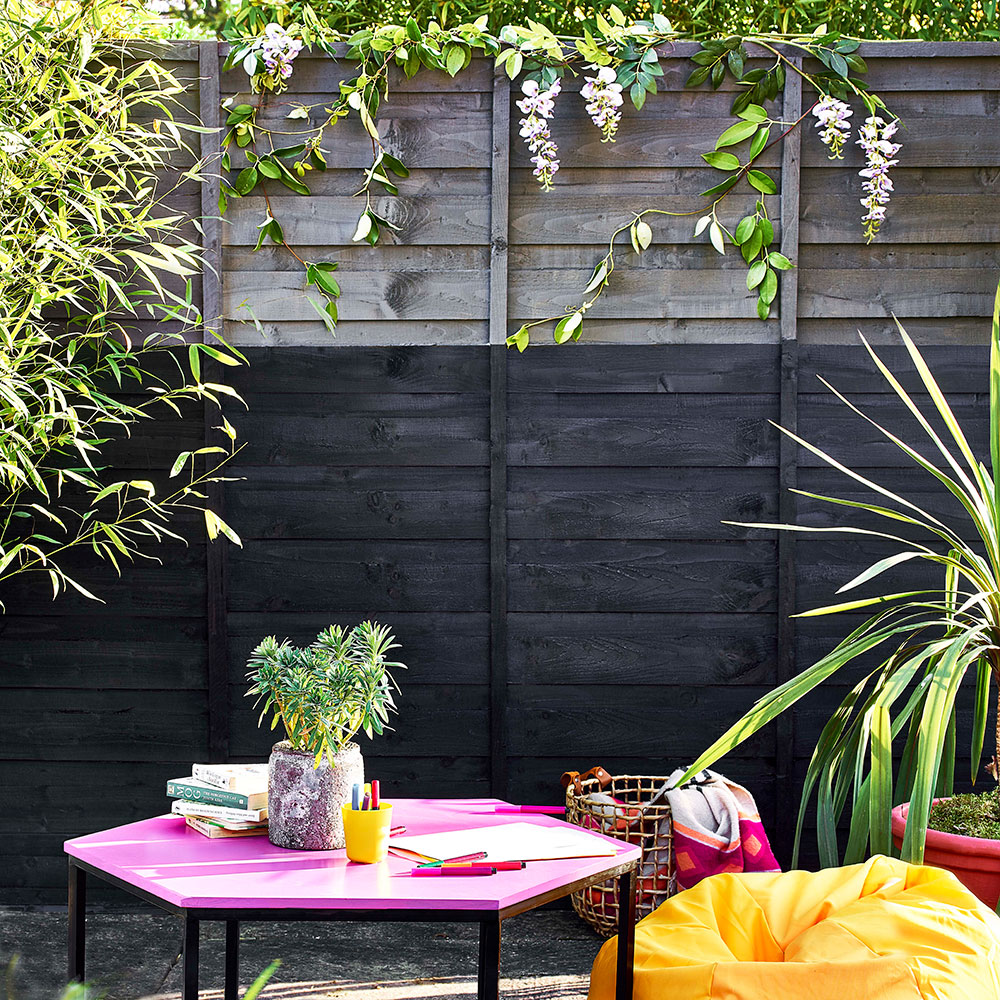
Why not mix it up by learning how to paint a fence with two colours?
'Create a striking look for your fence in two tones,' says Marianne Shillingford, creative director at Cuprinol & Dulux. 'Keep the darker colour at the bottom to show off brightly coloured furniture and to make floral arrangements pop.
'All it takes is a bit of masking tape to get a sharp line between the divide.'
17. Soften the look with slatted fencing
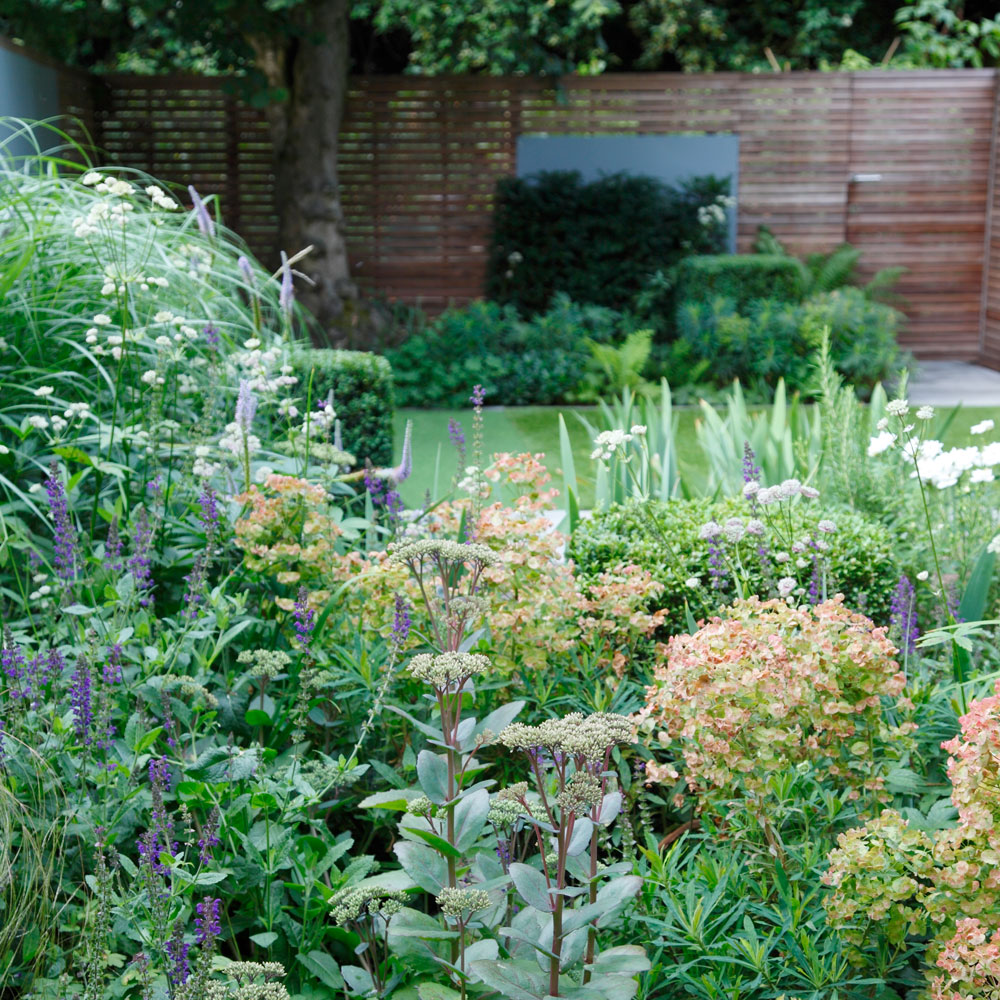
If your property is not overlooked, a slatted fence is a softer approach to setting the boundaries of a garden, without making it feel enclosed.
The slim gaps between the slats allow a glimpse of the greenery beyond, in a sense extending the view of the garden while still framing the grounds.
18. Repurpose old shutters as fences
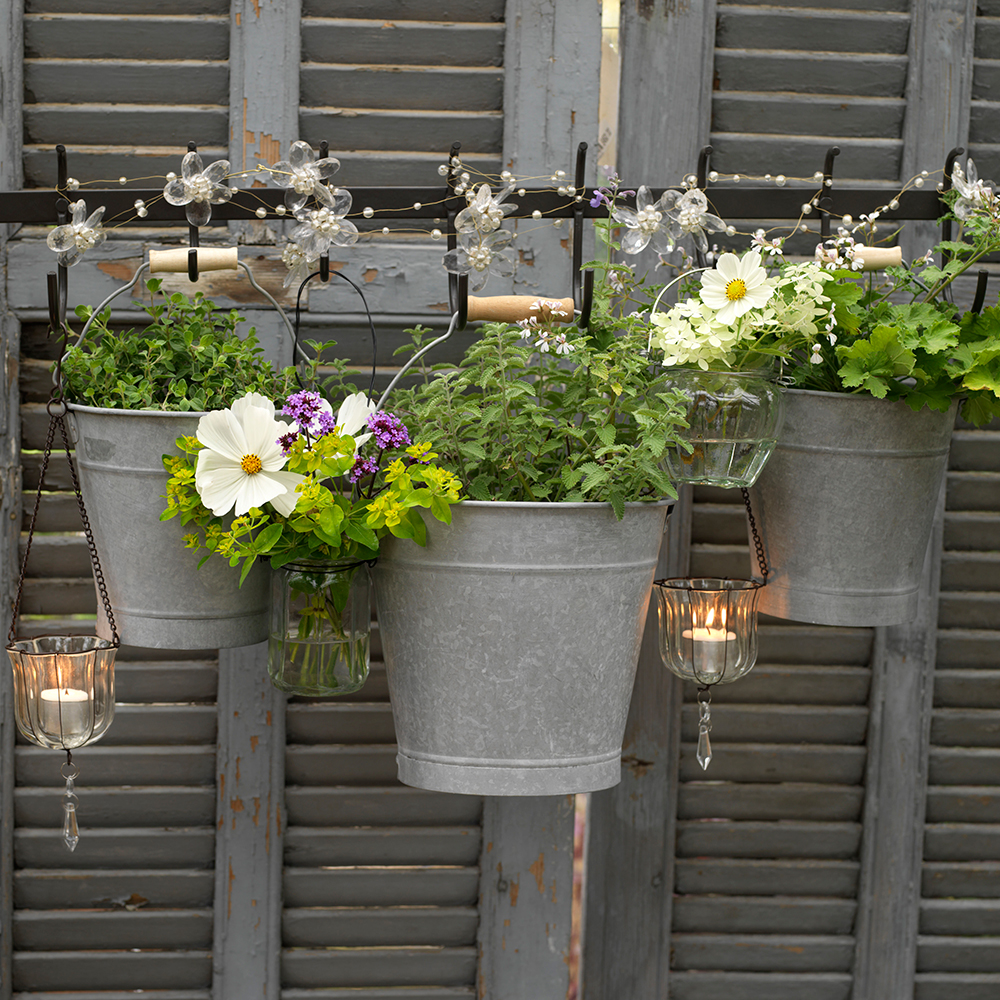
Create an innovative garden fence that has plenty of eco credentials by repurposing old shutters. It's a brilliant upcycling idea for the garden.
Start by giving the shutters a coat of paint. Grey is a good colour for a backdrop, as it goes with almost everything, but white would look fab, too, especially when it starts to become rougher and less pristine.
Add hooks to your shutter fence and use them to display pretty potted plants. Buckets work well, as their handles make them easy to hang.
19. Create privacy with a fence extension
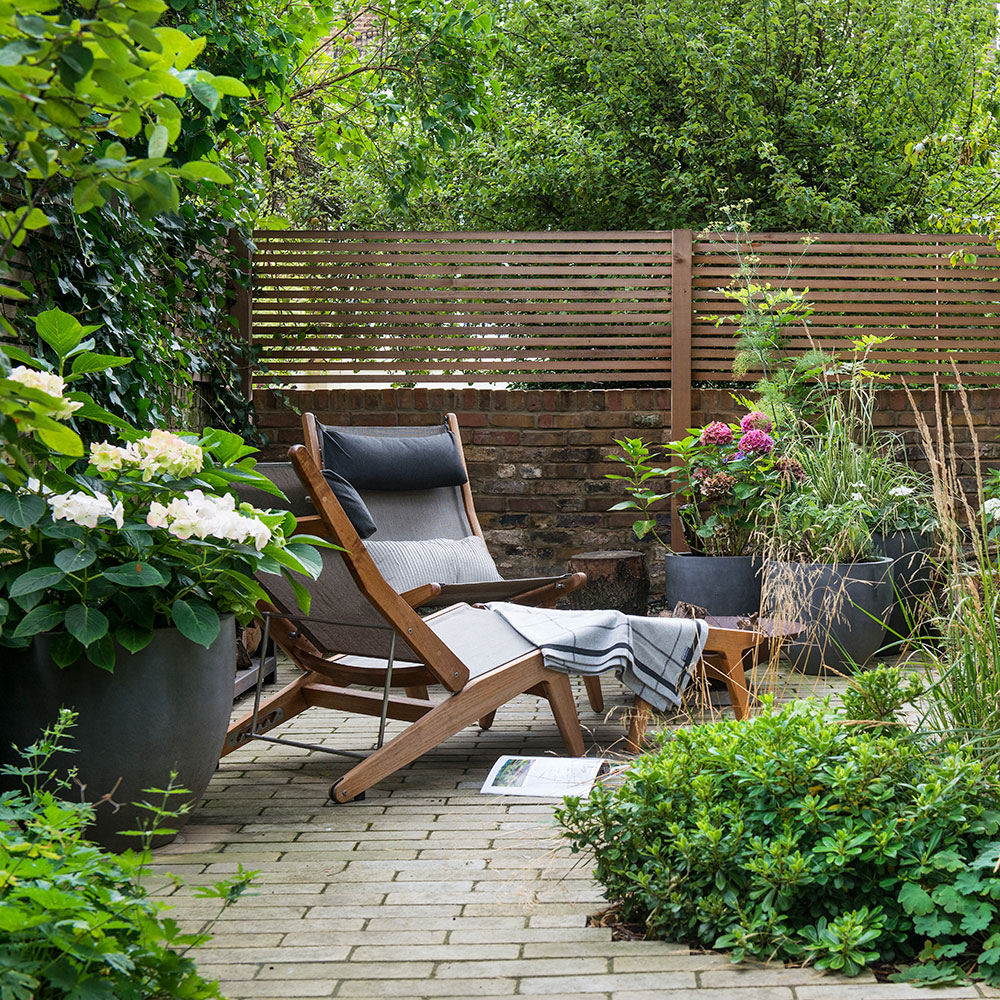
This beautiful low wall has so much character that it would be a shame to cover it up with full fence panels. Equally, building it higher to give the owners more privacy would be costly and could make the space feel too institutional.
This fence 'extension' has been carefully selected in a colour that complements the brickwork, and its horizontal slats have a contemporary feel to chime in with the landscaping's mix of traditional and modern.
20. Mount on an outdoor kitchen
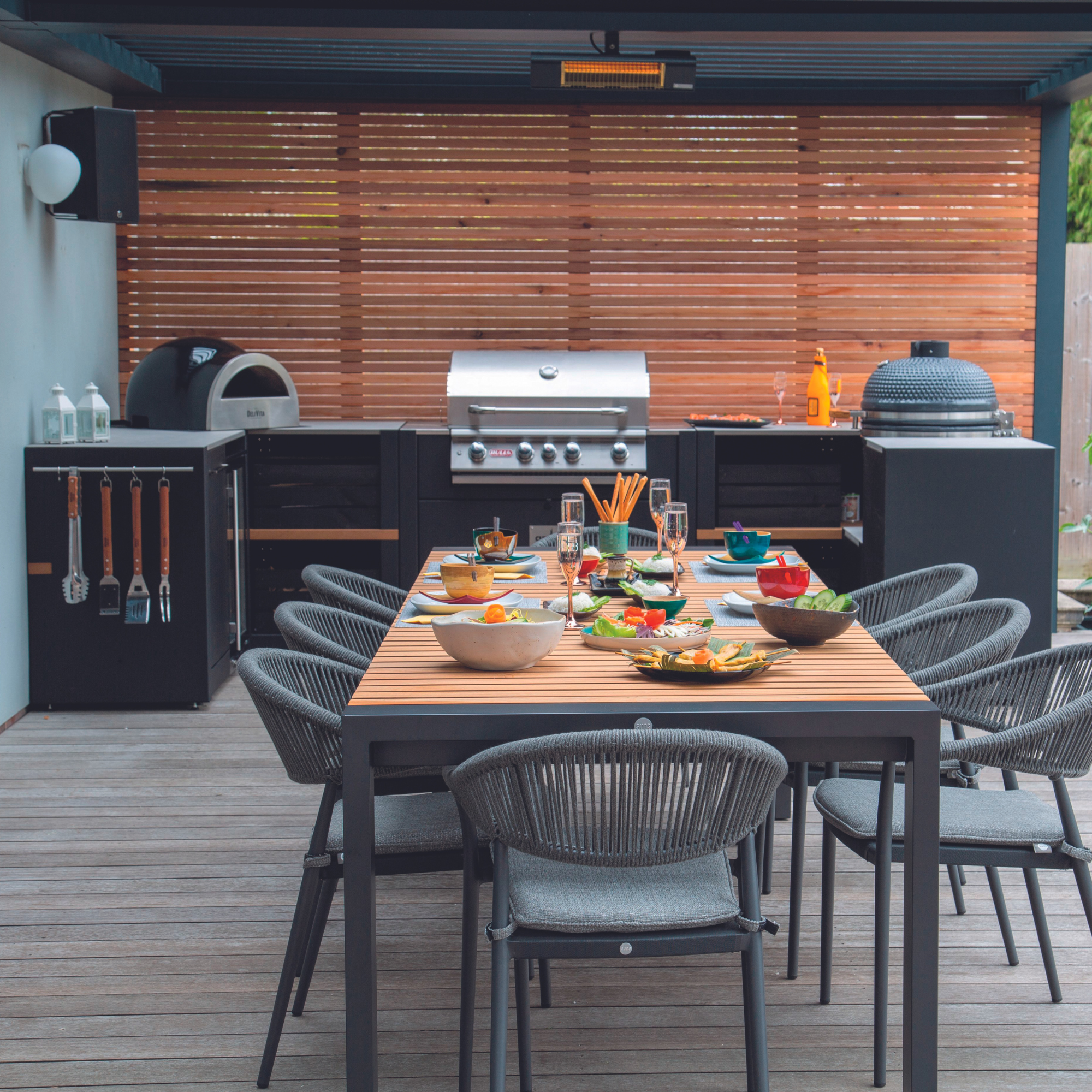
By adding a protective pergola above, a countertop and a shelf for storage, you can fulfil your outdoor kitchen ideas for next to nothing.
A little imagination, basic DIY skills and some timber can go a long way – add baskets for storing pots, pans and fuel for your outdoor cooker, and hang festoon lights so that you can cook well into the evening.
21. Camouflage with green
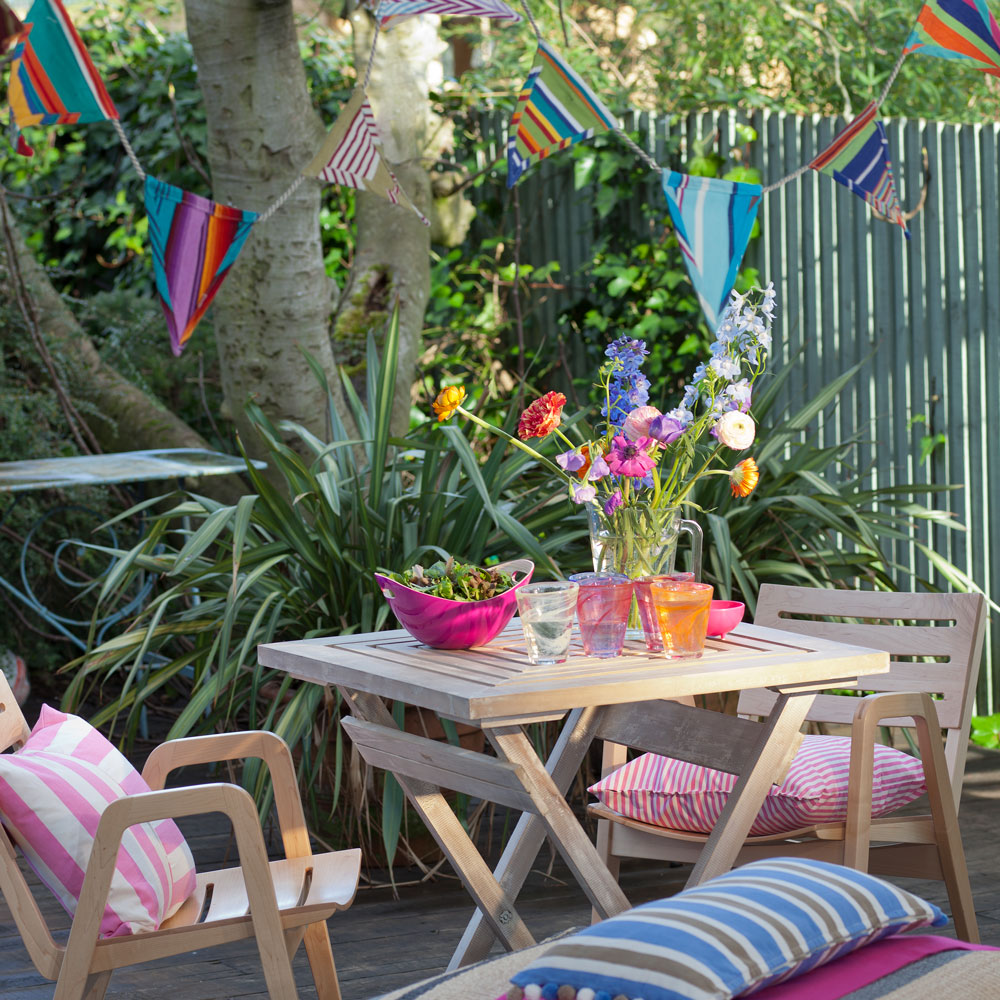
If you don't want your garden fence to stand out from the crowd with bold colours, make it blend in with a coat of green paint. A serene shade of green can help a garden fence blend into the foliage.
You can also add colour through other mediums, from a string of decorative bunting to jolly striped outdoor cushions.
22. Go for an on-trend grey fence
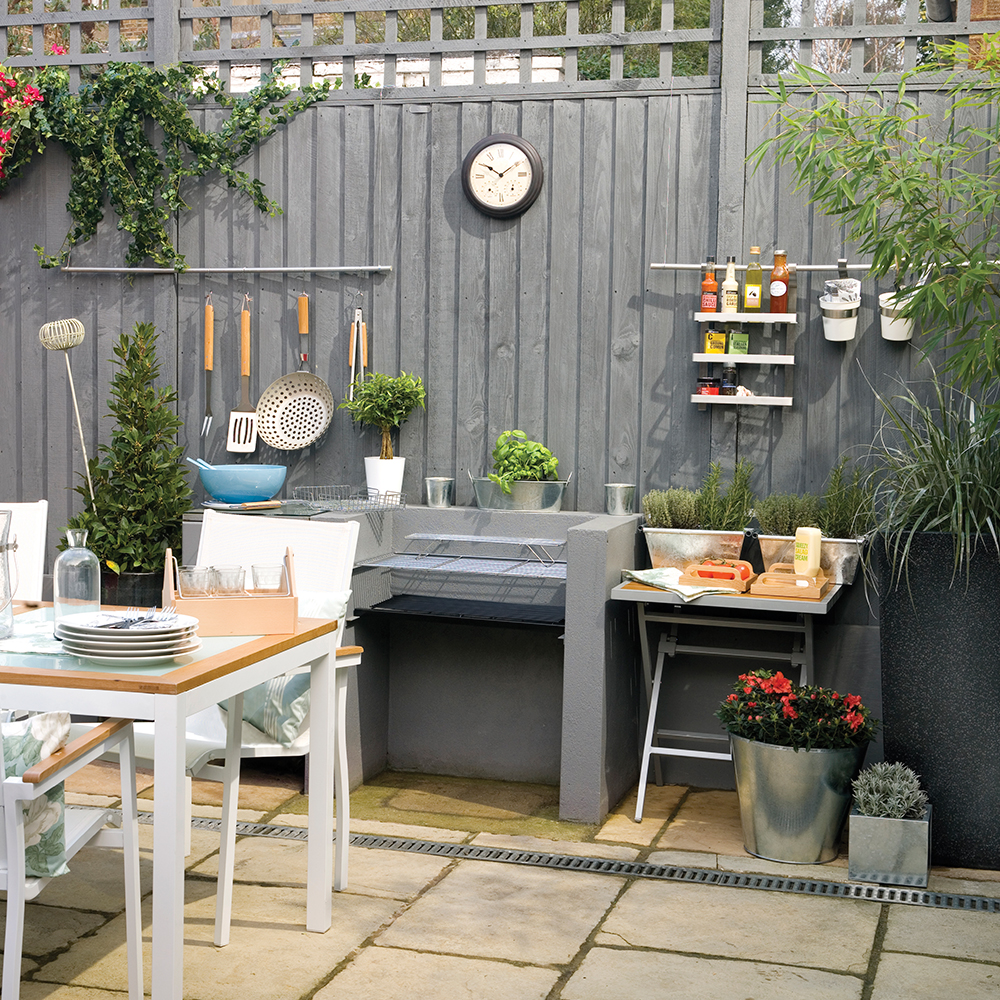
We love this grey fence – it provides a chic backdrop to the outdoor kitchen area and looks classy against the white shelving and hooks.
Simple accessories like an outdoor wall clock and potted plants make a real feature of the fence.
23. Go for rustic willow materials
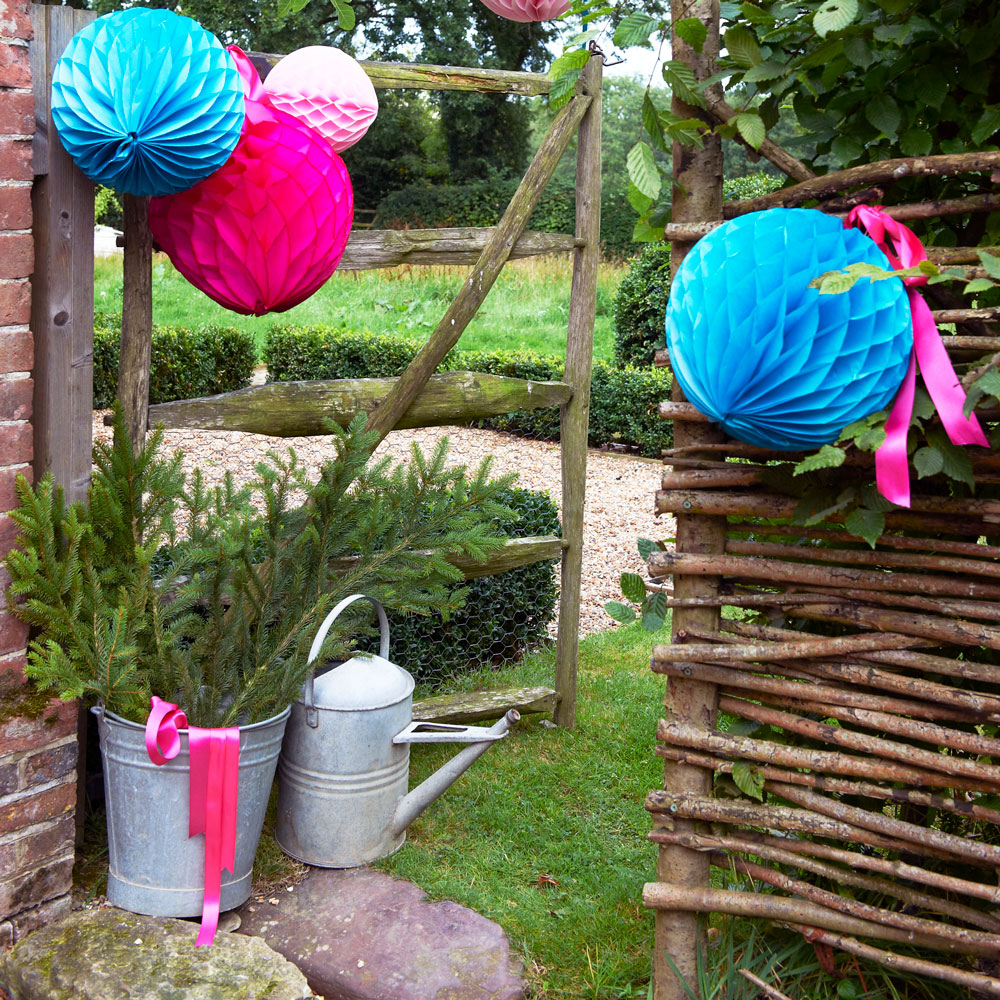
To prevent a garden fence from feeling too imposing or constraining, it's an idea to use rustic materials to break up the design.
A willow twig fence design is given a softer edge thanks to infilled panels of chicken wire, providing a secure design but allowing a view-through. Use this for the door and gates, teamed with willow woven fence panels for the main fenced area.
24. Decorate your garden fence with colourful tealight holders
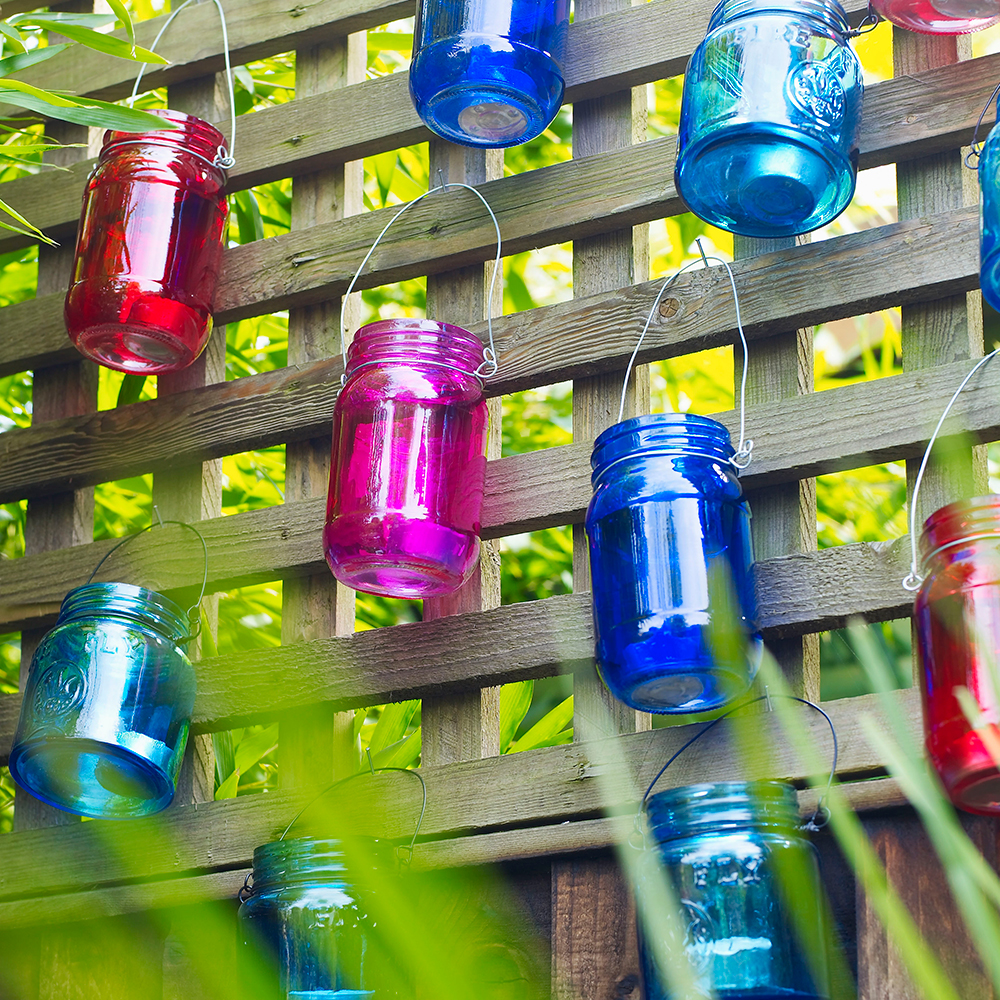
Take a garden fence with a trellis top and jazz it up with jam-jar-style tealight holders that look super pretty even during daylight hours.
Use secure but unobtrusive nails to hang them so that they almost look like they're floating. A variety of shades will work well, but clear jam-jar tealights would also look great. At night, enjoy their warm glow from the comfort of a nearby garden chair. Bliss.
25. Create a secluded dining area with willow fencing
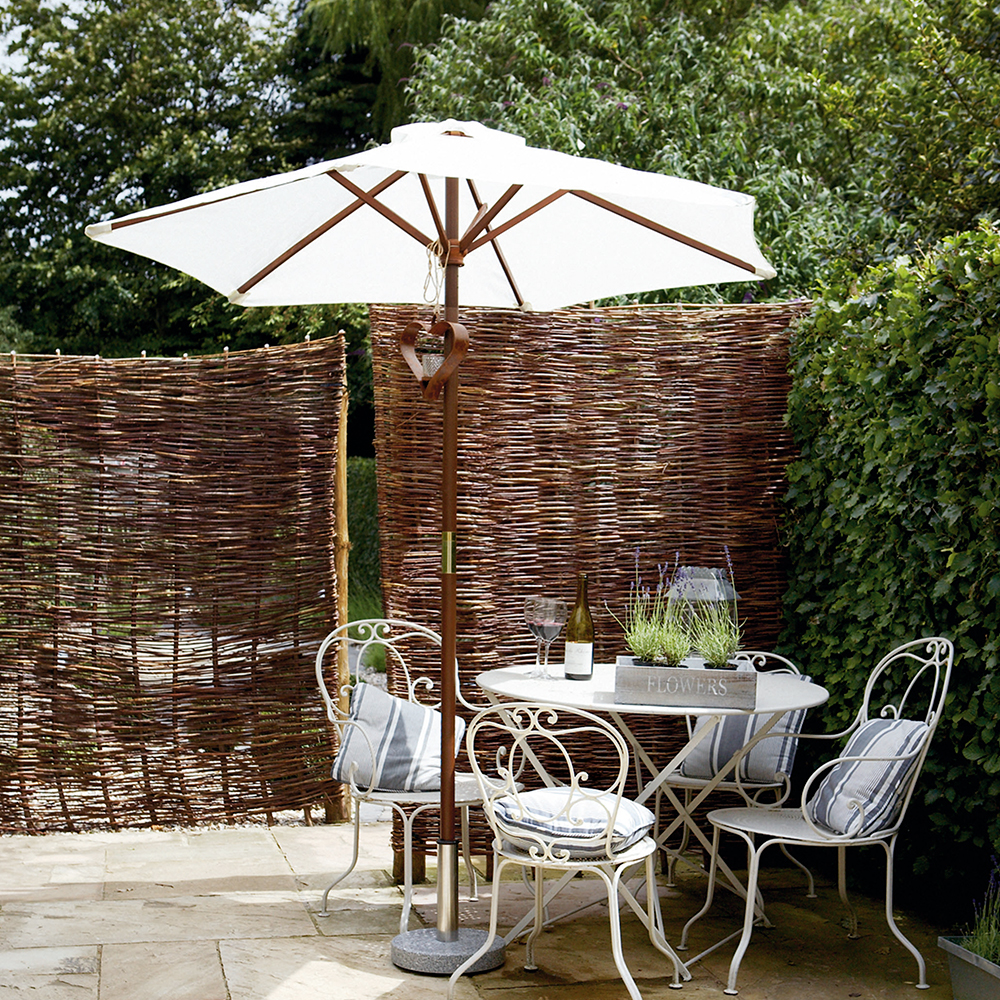
Go for an extra high garden fence to provide all the privacy you could ever need – especially if you have curious neighbours.
This fence features narrow lengths of willow that create a bamboo-style effect, ideal for screening an existing fence if you don't want to start completely from scratch. Willow screening fence panels can also add height to a short wall or fence, or you could even use it to keep the compost heap hidden from view.
26. Opt for a modern, low horizontal design
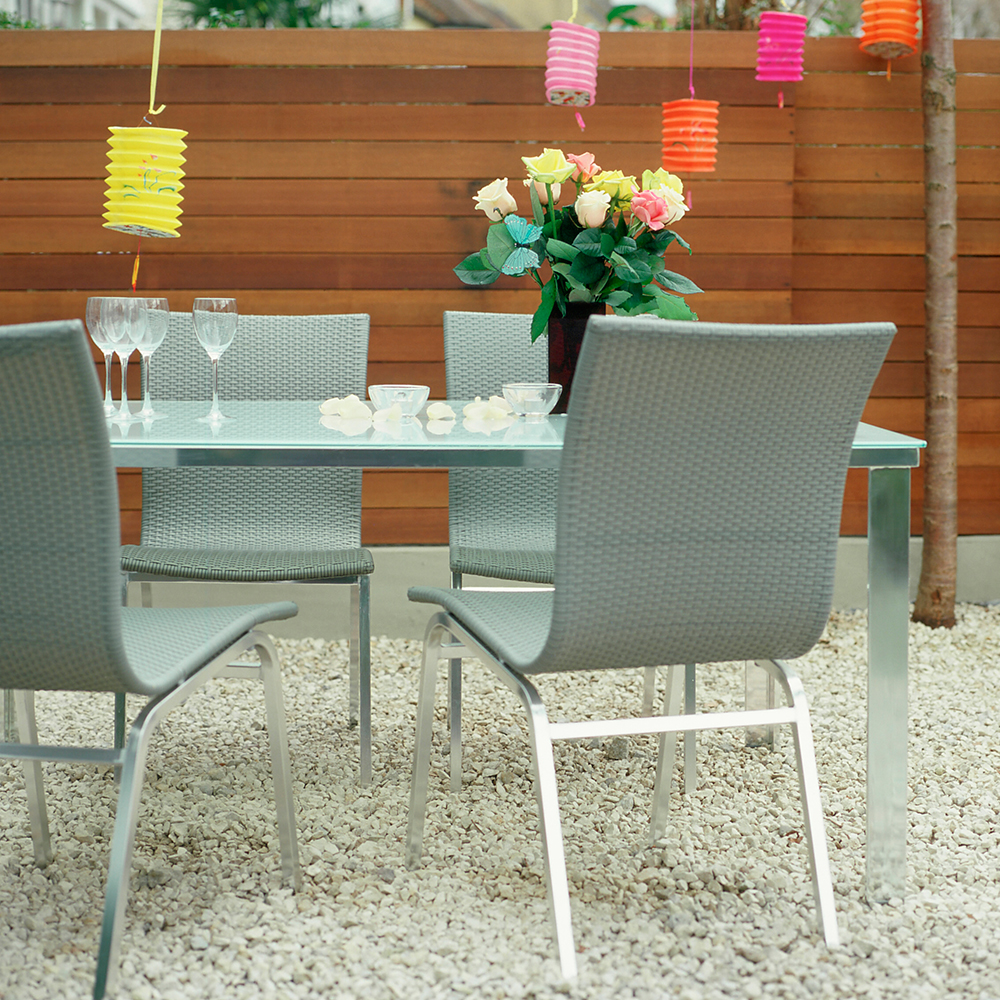
Mount a wooden garden fence on top of a concrete border for an elegant and modern scheme that has the feel of a room, complete with a 'skirting board'.
Not only does this contemporary garden fence look great, but it will also keep the gravel neatly in place. Go for horizontal wooden panels so that everything flows in a similar direction. A smart mid-toned varnish will be the perfect finish.
27. Mix your materials to create an unique look
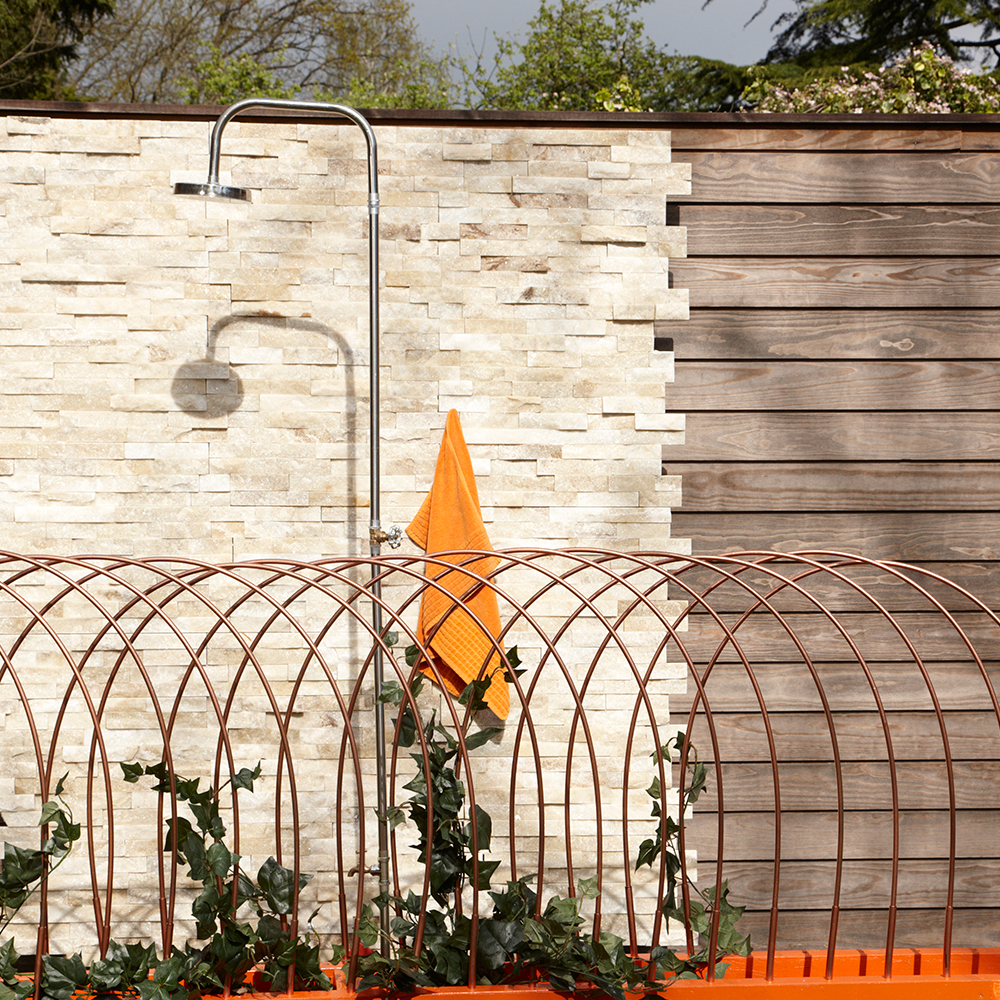
For unique garden fence ideas, combine stone and wood in a Jenga-style arrangement.
Here, this has been applied not just for the effect, but also for practicality – stone will endure a good soaking from the outdoor shower far better than wood. With a garden fence like this, the emphasis is on quality natural materials.
28. Charm with a picturesque picket fence
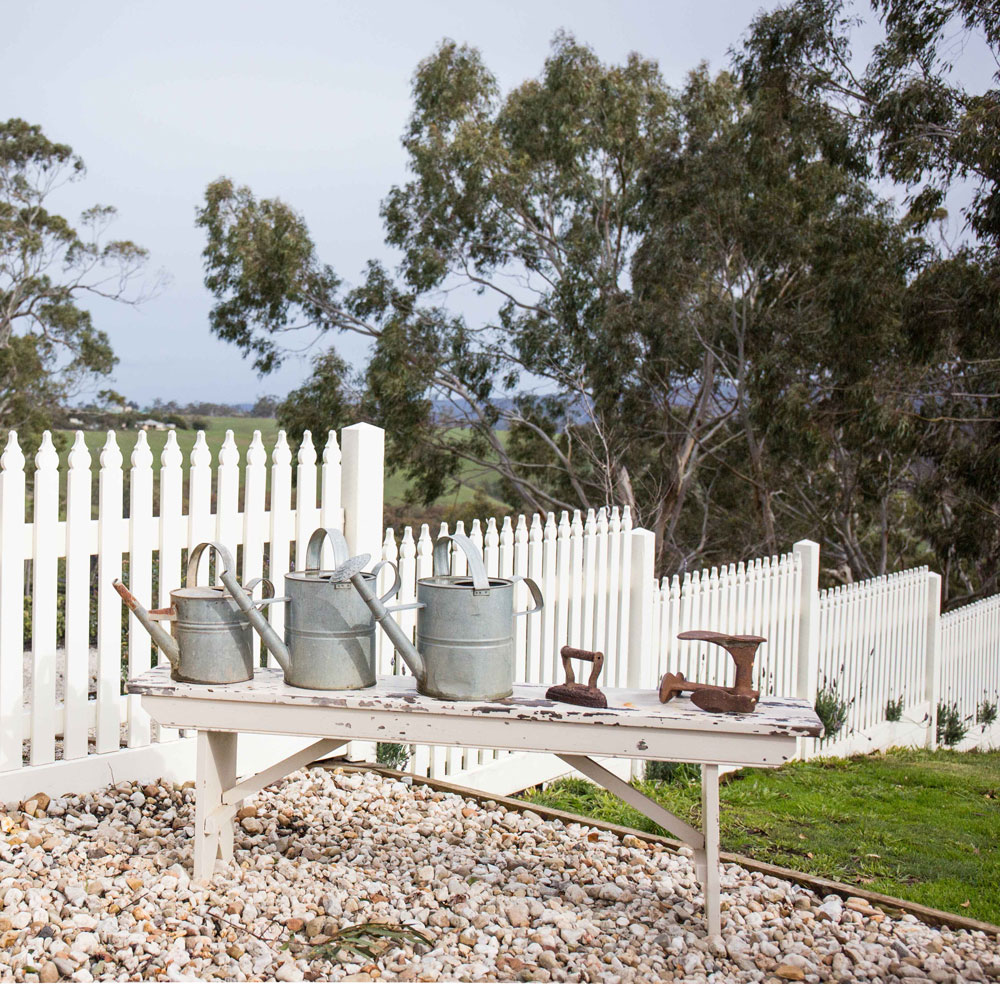
When it comes to garden fence ideas, you can't get much more idyllic than a traditional white picket fence surrounding the property.
A charming picket fence in white is ideal for both front gardens and back gardens to create a picturesque garden enclosure for your home.
As picket fencing only offers a low-level partition, it might not be suitable for homes that require more security, such as households with children and pets.
29. Paint your picket fence in an array of colours
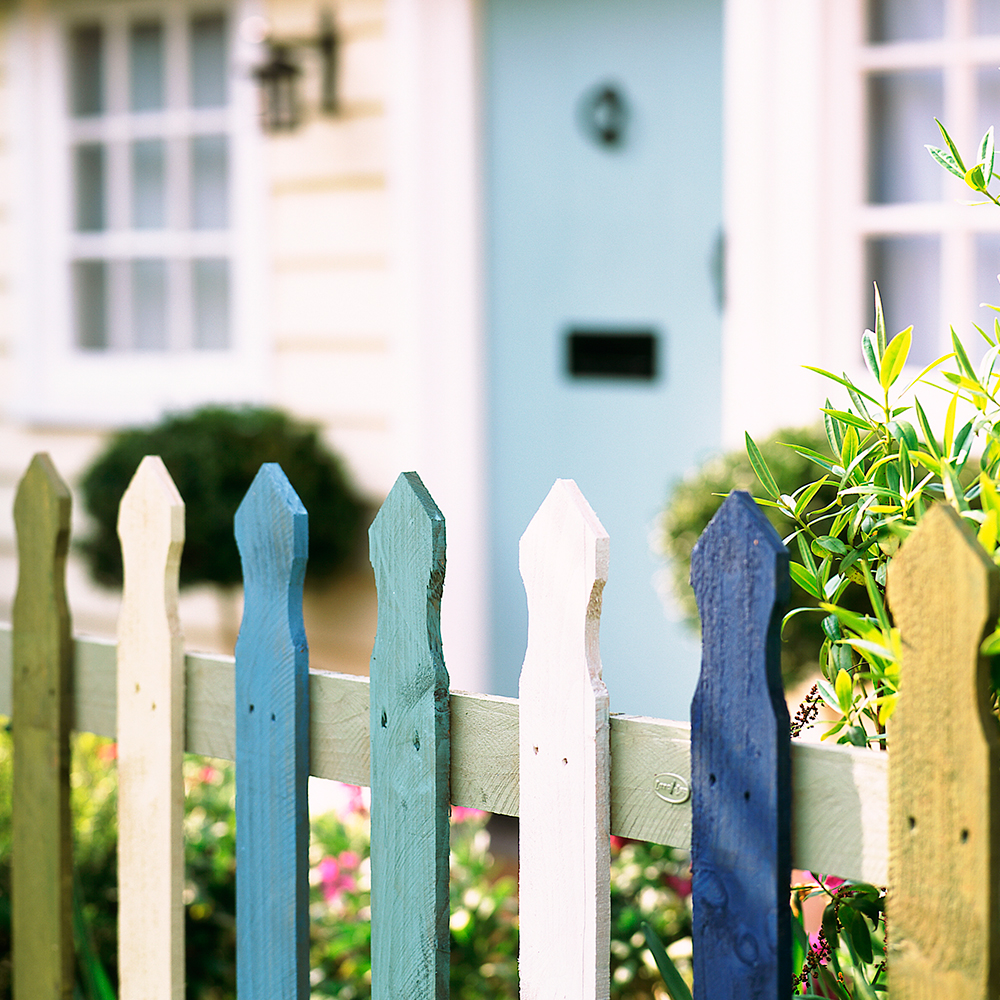
You don't have to stick to a white picket fence – when it comes to colours, the options are endless.
This design has been painted in colourful shades that make passers-by feel that bit happier. We all dream of a white picket fence, but if you're lucky enough to have one, why not take the plunge and go for something a little more daring? Paint your fence in pastel hues for a pretty, rather than garish, look.
Get the look
FAQs
What is the cheapest fencing for a garden?
Garden fencing can be affordable, but you'll want to make sure you're investing in sturdy panels for long-term value.
'While we recommend investing in high-quality fencing with a long guarantee to avoid costly replacements in the future, there are ways to reduce costs initially,' says Leigh Barnes from Jacksons Fencing.
'First, check the height you need. Garden fence panels are typically 1.8 metres high, but slightly lower heights such as 1.65-metre panels are cheaper without being drastically shorter. However, ensure shorter heights do not compromise your privacy needs. Always include gravel boards underneath to protect the fence from rot and add extra height.
'Traditional or kit-form fencing, like featherboard is built on-site from posts, rails, and pales. This type of fencing is generally the most cost-efficient, allowing you to order exact quantities to avoid wastage. Remember that it may take longer to install, so factor in time, too.'
Which garden fence ideas will you be trying?
Jennifer is the Deputy Editor (Digital) for Homes & Gardens online. Prior to her current position, she completed various short courses a KLC Design School, and wrote across sister brands Ideal Home, LivingEtc, 25 Beautiful Homes, Country Homes & Interiors, and Style at Home.
- Sophie KingGardens Editor
- Imani CottrellContent Editor
